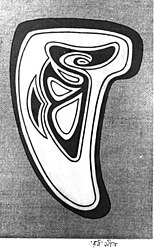ରବୀନ୍ଦ୍ରନାଥ ଠାକୁର
ରବୀନ୍ଦ୍ରନାଥ ଠାକୁର | |
|---|---|
 ରବୀନ୍ଦ୍ରନାଥ ଠାକୁର କୋଲକାତାରେ,୧୯୧୫ | |
| ଜନ୍ମ ଓ ଜନ୍ମସ୍ଥାନ | ମଇ ୭, ୧୮୬୧ କଲିକତା |
| ମୃତ୍ୟୁ | ୭ ଅଗଷ୍ଟ ୧୯୪୧ (ବୟସ ୮୦) କଲିକତା |
| ବୃତ୍ତି | କବି,ଚିତ୍ରଶିଳ୍ପୀ |
| ଭାଷା | ବଙ୍ଗଳା |
| ସାହିତ୍ୟ କୃତି | ଗୀତାଞ୍ଜଳି,ଗୋରା,ଜନ ଗଣ ମନ |
| ପୁରସ୍କାର | ସାହିତ୍ୟରେ ନୋବେଲ ପୁରସ୍କାର,୧୯୧୩ |
| ଜୀବନସାଥୀ | ମୃଣାଳୀନୀ ଦେବୀ |
| ଦସ୍ତଖତ | |
'ରବୀନ୍ଦ୍ରନାଥ ଠାକୁର '[a] (/rəˈbindrəˈnɑːt ˈtɑːɡɔːr/ (![]() listen); Bengali pronunciation: [robind̪ro nat̪ʰ ʈʰakur]), (୧୮୬୧-୧୯୪୧) [b] ଏକାଧାରରେ ଜଣେ କବି, ଚିତ୍ରଶିଳ୍ପୀ, ସଂଗୀତଜ୍ଞ, ଶିକ୍ଷାବିତ, ଗାଳ୍ପିକ ଓ ଦାର୍ଶନିକ ଥିଲେ । ତାଙ୍କୁ ବଙ୍ଗଳା ଭାଷାର ସର୍ବଶ୍ରେଷ୍ଠ ସାହିତ୍ୟକ ବୋଲି ଧରାଯାଏ । ଭାରତୀୟ ଭାଷା ଅନୁସାରେ ତାଙ୍କ ନାମ ରବିଦ୍ରନାଥ ଠାକୁର ଥିଲା । [୧] ତାଙ୍କୁ "ବଙ୍ଗଳାର ପକ୍ଷୀ" ବୋଲି ଆଖ୍ୟା ଦିଆଯାଇଥିଲା ।[୨]ଭାରତୀୟମାନଙ୍କ ମଧ୍ୟରେ ସେ ସର୍ବ ପ୍ରଥମେ ନୋବେଲ ପୁରସ୍କାର ଲାଭ କରିଥିଲେ । ଟାଗୋର ବହୁତ ଗଳ୍ପ, କବିତା, ଓ ନାଟକ ରଚନା କରିଥିଲେ ଓ ତା' ସହ ବହୁତ ଗୀତ ଓ ସଙ୍ଗୀତ ଲେଖିଥିଲେ । ରବୀନ୍ଦ୍ରନାଥଙ୍କ ୫୨ଟି କାବ୍ୟଗ୍ରନ୍ଥ, ୩୮ଟି ନାଟକ, ୧୩ଟି ଉପନ୍ୟାସ, ୩୬ଟି ପ୍ରବନ୍ଧ, ୯୬ କ୍ଷୁଦ୍ର ଗଳ୍ପ ଓ ୧୯୧୫ ସଙ୍ଗୀତ ପ୍ରକାଶିତ ହୋଇସାରିଛି । ରବୀନ୍ଦ୍ରନାଥଙ୍କ ରଚନା ବିଭିନ୍ନ ଭାଷାରେ ଅନୁବାଦିତ ହୋଇସାରିଛି । ଗୀତାଞ୍ଜଳିର ଲେଖକ ଓ ତାଙ୍କର ଗଭୀର ସମ୍ବେଦନଶୀଳ, ତାଜା, ସୁମଧୁର କବିତା; ୧୯୧୩ ମସିହାରେ ଗୀତାଞ୍ଜଳି କବିତାଗ୍ରନ୍ଥର ଇଂରାଜୀ ଅନୁବାଦ ପାଇଁ ସେ ନୋବେଲ ପୁରସ୍କାର ଲାଭ କରିଥିଲେ । [୩]ତାଙ୍କଦ୍ୱାରା ରଚିତ ସଂଗୀତ ୨ଟି ଦେଶ, ନିଜ ନିଜ ଦେଶର ଜାତୀୟ ସଂଗୀତ ଭାବେ ବାଛି ନେଇଛନ୍ତି: ଭାରତ "ଜନ ଗଣ ମନ" ଓ ବାଂଲାଦେଶ "ଆମର୍ ସୋନାର ବଙ୍ଗଲା" । ଶ୍ରୀଲଙ୍କାର ଜାତୀୟ ସଂଗୀତ ମଧ୍ୟ ଟାଗୋରଙ୍କଠାରୁ ପ୍ରେରଣା ଲାଭ କରିଥିଲା । [୪][୫][୬][୭][୮]
listen); Bengali pronunciation: [robind̪ro nat̪ʰ ʈʰakur]), (୧୮୬୧-୧୯୪୧) [b] ଏକାଧାରରେ ଜଣେ କବି, ଚିତ୍ରଶିଳ୍ପୀ, ସଂଗୀତଜ୍ଞ, ଶିକ୍ଷାବିତ, ଗାଳ୍ପିକ ଓ ଦାର୍ଶନିକ ଥିଲେ । ତାଙ୍କୁ ବଙ୍ଗଳା ଭାଷାର ସର୍ବଶ୍ରେଷ୍ଠ ସାହିତ୍ୟକ ବୋଲି ଧରାଯାଏ । ଭାରତୀୟ ଭାଷା ଅନୁସାରେ ତାଙ୍କ ନାମ ରବିଦ୍ରନାଥ ଠାକୁର ଥିଲା । [୧] ତାଙ୍କୁ "ବଙ୍ଗଳାର ପକ୍ଷୀ" ବୋଲି ଆଖ୍ୟା ଦିଆଯାଇଥିଲା ।[୨]ଭାରତୀୟମାନଙ୍କ ମଧ୍ୟରେ ସେ ସର୍ବ ପ୍ରଥମେ ନୋବେଲ ପୁରସ୍କାର ଲାଭ କରିଥିଲେ । ଟାଗୋର ବହୁତ ଗଳ୍ପ, କବିତା, ଓ ନାଟକ ରଚନା କରିଥିଲେ ଓ ତା' ସହ ବହୁତ ଗୀତ ଓ ସଙ୍ଗୀତ ଲେଖିଥିଲେ । ରବୀନ୍ଦ୍ରନାଥଙ୍କ ୫୨ଟି କାବ୍ୟଗ୍ରନ୍ଥ, ୩୮ଟି ନାଟକ, ୧୩ଟି ଉପନ୍ୟାସ, ୩୬ଟି ପ୍ରବନ୍ଧ, ୯୬ କ୍ଷୁଦ୍ର ଗଳ୍ପ ଓ ୧୯୧୫ ସଙ୍ଗୀତ ପ୍ରକାଶିତ ହୋଇସାରିଛି । ରବୀନ୍ଦ୍ରନାଥଙ୍କ ରଚନା ବିଭିନ୍ନ ଭାଷାରେ ଅନୁବାଦିତ ହୋଇସାରିଛି । ଗୀତାଞ୍ଜଳିର ଲେଖକ ଓ ତାଙ୍କର ଗଭୀର ସମ୍ବେଦନଶୀଳ, ତାଜା, ସୁମଧୁର କବିତା; ୧୯୧୩ ମସିହାରେ ଗୀତାଞ୍ଜଳି କବିତାଗ୍ରନ୍ଥର ଇଂରାଜୀ ଅନୁବାଦ ପାଇଁ ସେ ନୋବେଲ ପୁରସ୍କାର ଲାଭ କରିଥିଲେ । [୩]ତାଙ୍କଦ୍ୱାରା ରଚିତ ସଂଗୀତ ୨ଟି ଦେଶ, ନିଜ ନିଜ ଦେଶର ଜାତୀୟ ସଂଗୀତ ଭାବେ ବାଛି ନେଇଛନ୍ତି: ଭାରତ "ଜନ ଗଣ ମନ" ଓ ବାଂଲାଦେଶ "ଆମର୍ ସୋନାର ବଙ୍ଗଲା" । ଶ୍ରୀଲଙ୍କାର ଜାତୀୟ ସଂଗୀତ ମଧ୍ୟ ଟାଗୋରଙ୍କଠାରୁ ପ୍ରେରଣା ଲାଭ କରିଥିଲା । [୪][୫][୬][୭][୮]
ଗୋଟେ ପିରାଲୀ ବ୍ରାହ୍ମଣ କଲିକତାର ପୈତୃକ ସମ୍ଭ୍ରାନ୍ତ ଶ୍ରେଣୀର ଲୋକ ଜେସର ସହର ସହ ସମ୍ପର୍କିତ, ସେ ଯେତେବେଳେ ୮ବର୍ଷ ବୟସର ହେଇଥିଲେ ସେତେବେଳେ ସେ ଲେଖା ଆରମ୍ଭ କରିଥିଲେ ।[୯] ଷୋହଳ ବର୍ଷ ବୟସରେ, ସେ ଭାନୁସିଂହ ନାମକ ଛଦ୍ମ ନାମ ଉପଯୋଗ କରି ନିଜର କବିତାକୁ ଉନ୍ମୋଚନ କରିଥିଲେ । ସେହି କବିତାଗୁଡିକୁ ସାହିତ୍ୟିକ ମହଲରୁ ଅନେକ ପ୍ରଶଂସା କରାଯାଇଥିଲା । [୧୦][୧୧] ଅନୁବାଦରେ ତାଙ୍କ କବିତା ଅଧ୍ୟତ୍ମିକ ଓ ସୁଲଳିତ ଥିଲା,କିନ୍ତୁ ତାଙ୍କର ରୁଚିପୂର୍ଣ ଗଳ୍ପ ଓ ସୁମଧୁର କବିତା ବହୁତ ସମୟ ପର୍ଯ୍ୟନ୍ତ ବଙ୍ଗଳା ବାହାରେ ଜଣା ନ ଥିଲା ।୧୮୭୭ ମସିହାରେ ସେ ନିଜେ ଛୋଟ ଗଳ୍ପ ଓ ନାଟକ ନିଜ ନାମରେ ପ୍ରକାଶନ କରି ଥିଲେ । ସେ ଜଣେ ମାନବବାଦୀ, ଭୌମିକତା, ଅନ୍ତରାଷ୍ଟ୍ରୀୟବେଦୀ ଥିଲେ । [୧୨] ସେ ବ୍ରିଟିଶ ଶାସନର ନିନ୍ଦା ଓ ଭାରତର ସ୍ୱଧୀନ ପାଇଁ ଓକିଲାତି କରୁଥିଲେ । ବଙ୍ଗଳା ପୁନଃଜାଗରଣ ର ପ୍ରତିବାଦକ ରୂପରେ ,ସେ ଚିତ୍ର, ଚିତ୍ରାଙ୍କନ , ୧୦୦ ବହି, କିଛି ୨୦୦୦ ସଂଖ୍ୟକ କବିତା, ଇଚ୍ଛାପତ୍ର ସାମିଲ ଥିଲା, ତାଙ୍କଦ୍ୱାରା ବିଶ୍ୱ ଭାରତୀୟ ବିଶ୍ୱବିଦ୍ୟାଳୟ ସ୍ଥାପିତ ହୋଇଥିଲା ।[୧୩][୧୪][୧୫][୧୬][୧୭]
ବାଲ୍ୟ ଜୀବନ (୧୮୬୧-୧୯୦୧)
[ସମ୍ପାଦନା]ଟାଗୋରଙ୍କ ପିଲାବେଳ ନାମ "ରବି" ବା "ରୋବି" ଥିଲା।ପରିବାରର ୧୪ ପିଲାଙ୍କ ମଧ୍ୟରେ ସେ ବାପା ମା'ଙ୍କ ସବୁଠୁ ସାନ ପୁଅ ଥିଲେ । ସେ ଜୋରସଙ୍କୋ mansion କଲିକତାରେ ଜନ୍ମଗ୍ରହଣ କରିଥିଲେ । ତାଙ୍କ ବାପାଙ୍କ ନାମ ଦେବେନ୍ଦ୍ରନାଥ ଟାଗୋର (୧୮୧୭-୧୯୦୫) ଓ ମା'ଙ୍କ ନାମ ଶାରଦା ଦେବୀ(୧୮୩୦-୧୮୭୫) ଥିଲା । [c]
The last two days a storm has been raging, similar to the description in my song—Jhauro jhauro borishe baridhara [... amidst it] a hapless, homeless man drenched from top to toe standing on the roof of his steamer [...] the last two days I have been singing this song over and over [...] as a result the pelting sound of the intense rain, the wail of the wind, the sound of the heaving Gorai [R]iver, have assumed a fresh life and found a new language and I have felt like a major actor in this new musical drama unfolding before me.
ଟାଗୋର ଛୋଟବେଳୁ ତାଙ୍କ ଚାକରମାନଙ୍କଦ୍ୱାରା ଲାଳନ ପାଳନ ହୋଇଥିଲେ; କାରଣ ଛୋଟବେଳୁ ତାଙ୍କ ମା'ଙ୍କର ମୃତ୍ୟୁ ହୋଇଯାଇଥିଲା ଓ ତାଙ୍କ ବାପା ଅଧିକାଂଶ ସମୟ ଦୂରକୁ ଯାତ୍ରା କରୁଥିଲେ ।[୨୪] ଟାଗୋର ପରିବାର ବଙ୍ଗଳାର ପୁର୍ନଜାଗରଣରେ ସବୁଠୁ ଆଗରେ ଥିଲେ । ଟାଗୋରଙ୍କ ବଡ଼ ଭାଇ ଦ୍ୱିଜେନ୍ଦ୍ରନାଥ ଜଣେ ଦାର୍ଶନିକ ଓ କବି ଥିଲେ । ଆଉ ଜଣେ ଭାଇ ସତ୍ୟନ୍ଦରନାଥ, ଭାରତର ପ୍ରଥମ ସମସ୍ତ-ୟୁରୋପୀୟ ଇଣ୍ଡିଆନ ସିଭିଲ ସର୍ଭିସରେ ନିଯୁକ୍ତି ପାଇଥିଲେ । ଆଉ ଜଣେ ଭାଇ, ଜ୍ୟୋତିନ୍ଦ୍ରନାଥ ସଂଗୀତକାର, ନାଟ୍ୟକାର, ଓ ରଚୟିତା ଥିଲେ ।[୨୫]ତାଙ୍କ ଭଉଣୀ ସ୍ୱର୍ଣ୍ଣ କୁମାରୀ ଦେବୀ ଜଣେ ଔପନାସିକା ଥିଲେ । [ଆଧାର ଲୋଡ଼ା]ତାଙ୍କ ଭାଇ ଜୟୋତିନ୍ଦ୍ରନାଥଙ୍କ ସ୍ତ୍ରୀ କଦମ୍ବରୀ,ସେ ରବିଦ୍ରନାଥଙ୍କଠାରୁ ଅଳ୍ପ ବୟସ ବଡ଼ ଥିଲେ, ସେ ଟାଗୋରଙ୍କ ଭଲ ସାଙ୍ଗ ଏବଂ ଶକ୍ତିଶାଳୀ ପ୍ରବର୍ତ୍ତକା ଥିଲେ । ସେ ୧୮୮୪ ମସିହାରେ ଆକସ୍ମିକ ଭାବେ ଆତ୍ମହତ୍ୟା କରିଦେଇଥିଲେ, ଟାଗୋରଙ୍କ ବାହାଘର ପରେ, କିଛି ବର୍ଷ ପୂର୍ବେ ସେ ଗଭୀର ମାନସିକ ଅଶାନ୍ତିରେ ରହୁଥିଲେ। [ଆଧାର ଲୋଡ଼ା]
ଟାଗୋର ବହୁତ ପରିମାଣରେ ବିଦ୍ୟାଳୟଠାରୁ, ଶିକ୍ଷାଠୁ ଦୂରରେ ରହୁଥିଲେ, ଓ ସେ ତାଙ୍କ ପରିବାର ସହ ବୋଲପୁର ଏବଂ ପାନୀହାତ ବୁଲିବା ପସନ୍ଦ କରୁଥିଲେ । [୨୬][୨୭] ତାଙ୍କ ଭାଇ ହେମେନ୍ଦ୍ରନାଥ ଟାଗୋର ତାଙ୍କୁ ପଢ଼ାଉଥିଲେ ଓ ଶାରିରୀକ ଶିକ୍ଷା ଦେଉଥିଲେ: ଗଙ୍ଗାରେ ପହଁରିବା, ପାହାଡ଼ ଚଢ଼ିବା, ବ୍ୟାୟାମ ବିଦ୍ୟା, ଜୁଡ଼ୋ ଅଭ୍ୟାସ, ଓ କୁସ୍ତି/ ମଲ୍ଲଯୁଦ୍ଧ । ସେ ଚିତ୍ରକଳା, ବିଜ୍ଞାନ, ଇତିହାସ, ଭୂଗୋଳ, ଗଣିତ, ସାହିତ୍ୟ, ସଂସ୍କୃତ, ଓ ଇଂରାଜୀ ଇତ୍ୟାଦି ତାଙ୍କ ପସନ୍ଦର ବିଷୟରେ ଶିକ୍ଷା ଗ୍ରହଣ କରିଥିଲେ । [୨୮] ସେ ଗୋଟେ ଦିନ ପାଇଁ ପ୍ରେସିଡେନ୍ସି ମହାବିଦ୍ୟାଳୟ ଯାଇଥିଲେ । କିଛି ବର୍ଷ ପରେ ସେ କହିଥିଲେ ଯେ ଉଚିତ ଶିକ୍ଷା କିଛି ବ୍ୟାଖ୍ୟା ନକରି ଜିଜ୍ଞାସାକୁ ରୋକିଥାଏ । [୨୯]

ଉପନୟନ ପରେ,୧୮୭୩ ମସିହାରେ ଫେବୃଆରୀ ମାସରେ, ସେ ଯେତେବେଳେ ୧୧ବର୍ଷର ହୋଇଥିଲେ, ସେ ତାଙ୍କ ବାପାଙ୍କ ସହ ଭାରତ ପରିଦର୍ଶନ ଯାଇଥିଲେ । ସେ ଯାତ୍ରା ମାସ ମାସ ଧରି କରି ଥିଲେ । ସେ ବିଭିନ୍ନ ସ୍ଥାନ ପରିଦର୍ଶନ କରିଥିଲେ ,ତାହା ପଞ୍ଜାବର ଅମୃତସର ,ହିମାଳୟର ଡେଲହଉସି । ସେ ମଧ୍ୟ ଶାନ୍ତିନିକେତନ ତାଙ୍କ ବାପାଙ୍କ ସହ ଯାଇଥିଲେ । ସେଠାରେ ସେ ଆତ୍ମଜୀବନି ପଢ଼ି ଥିଲେ ଏବଂ ଇତିହାସ, ସଂସ୍କୃତ, ଆଧୁନିକ ବିଜ୍ଞାନ, ଓ ଜ୍ୟୋତିଷ ଶାସ୍ତ୍ର ର ଅଧ୍ୟୟନ କରିଥିଲେ । ସେ ମଧ୍ୟ କାଳୀଦାସ ଙ୍କ ବିଷୟରେ ପଢ଼ୁଥିଲେ । [୩୦][୩୧]
ସେ ମୈଥିଳି ଭାଷାରେ ସବୁଠୁ ଲମ୍ବା କବିତା ଲେଖି ଥିଲେ । ମିଥିଳାରେ ଲୋକମାନଂକର କଥିତ ଭାଷା ହଉଚି ମିଥିଲି । ଟାଗୋର ମିଥିଲି ଭାଷାରେ କବିତା ବିଦ୍ୟପତିଙ୍କ ପରି ଲେଖୁଥିଲେ, ବିଦ୍ୟାପତି ହେଉଛନ୍ତି ମିଥିଲି ଭାଷାର ଜଣେ ଖ୍ୟାତନାମ କବି । [୩୨] Regional experts accepted them as the lost works of Bhānusiṃha.[d] [୩୩] ସେ ପ୍ରଥମେ ବଙ୍ଗଳା ଭାଷାରେ ଛୋଟ ଗଳ୍ପ ଲେଖିଥିଲେ ତା ନାମ "ଭିକରିଣୀ"(ଭିକାରି ସ୍ତ୍ରୀ ଲୋକ) [୩୪] [୩୫] ,ସେହି ବର୍ଷ ସେ ସଂଧ୍ୟା ସଂଗୀତ(୧୮୮୨)ଓ କବିତା "ନିଲହରିତ ସ୍ୱପ୍ନଭଙ୍ଗା"(ଉତ୍ତେଜିତ ଜଳପ୍ରପାତ)
ଶିଳାଧା(୧୮୭୮-୧୯୦୧)
[ସମ୍ପାଦନା]
୧୮୭୮ [୨୩] ମସିହାରେ ସେ ଲଣ୍ଡନ ଯାଇଥିଲେ । ସେଠାରେ ସେ ବ୍ରିଟେନ, ଇଂଲଣ୍ଡ ପବ୍ଲିକ ବିଦ୍ୟାଳୟରେ ପଢ଼ିଥିଲେ । ସେ ଜଣେ ବ୍ରିଟିଶର ହୁଅନ୍ତୁ ବୋଲି ତାଙ୍କ ବାପା ଚାହୁଁଥିଲେ । ସେ ସେଠାରେ କିଛି ମାସ ଧରି ରହିଥିଲେ, ଟାଗୋରଙ୍କ ପରିବାର ବ୍ରିଟେନ ଓ ହୋବର ମେଡ଼ିଆନ ଭିଲାରେ ନିଜେ ଘର କିଣି ଥିଲେ: ୧୮୭୭ ମସିହାରେ ସେଠାରେ ତାଙ୍କ ଝିଅରୀ ଓ ପୁତୁରା (ସୁରେନ୍ଦ୍ର ଓ ଇନ୍ଦିରା ଦେବୀଙ୍କ ପିଲାମାନେ), ଟାଗୋରଙ୍କ ଭାଇ ସତ୍ୟନ୍ଦ୍ରନାଥ ତାଙ୍କ ମା'ଙ୍କ ଏବଂ ତାଙ୍କ ଭାଉଜଙ୍କ ସହ ରହୁଥିଲେ । [୩୬] ସେ ଶେଷରେ ଲଣ୍ଡନ ବିଶ୍ୱବିଦ୍ୟାଳୟରେ ପଢ଼ିଥିଲେ, କିନ୍ତୁ ସେ ସେଇ ସ୍କୁଲ ଛାଡିଦେଲେ । ନିଜ ସ୍ୱାଧୀନରେ ସେ ପଢ଼ିବାକୁ ଇଚ୍ଛାକଲେ, ସେ ସେକ୍ସପିଅର, ରିଲିଜିଓ ମିଡ଼ିସି (Religio Medici), କରିଓଲାନ୍ସ (Coriolanus) , ଆଣ୍ଟୋନି ଏବଂ କ୍ଲିଓପାଟ୍ରା (Antony and Cleopatra ) ପଢ଼ିଲେ । ଇଂଲିଶ, ଇର୍ରିସ(ଆୟରଲ୍ୟାଣ୍ଡ), ସ୍କୋଟିଷ୍(ସ୍କଟ୍ ଲ୍ୟାଣ୍ଡ)ଗୀତ ଟାଗୋରଙ୍କୁ ଉଲ୍ଲସିତ ଓ ଗଭୀର ପ୍ରଭାବ ପକାଇଥିଲା ।
ବିନା ଡିଗ୍ରୀରେ ୧୮୮୦ମସିହାରେ ବଙ୍ଗଳା ପ୍ରତ୍ୟାବର୍ତ୍ତନ କରିଥିଲେ, ସେ ସଫଳତା ପାଇବାରୁ ବଞ୍ଚିତ ହେଉଥିଲେ । ତାଙ୍କ ବାପା ତାଙ୍କର ପାଇଁ ନିଜେ ବାହାଘର ଠିକ କରିଥିଲେ ମୄଳାଲିଣି ଦେବୀଙ୍କ(୧୮୭୩-୧୯୦୨) ସହ, ସେ ମାତ୍ର ୧୦ ବର୍ଷ ବୟସର ଝିଅ ଥିଲେ (ବାଲ୍ୟ ବିବାହ), ତାଙ୍କ ଜନ୍ମ ଭାବତାରିଣୀରେ ହୋଇଥିଲା । ୧୮୮୩ ମସିହା ଡିସେମ୍ବର ୯ରେ ତାଙ୍କର ବିବାହ ହୋଇଥିଲା । ତାଙ୍କର ୫ଟି ସନ୍ତାନ ଥିଲେ, ୨ଜଣ ସନ୍ତାନ ଛୋଟ ବେଳୁ ମୃତ୍ୟୁ ବରଣ କରିଥିଲେ । [୩୭]
୧୮୯୦ ମସିହାରେ ପରିବାର ଚଳେଇବା ପାଇଁ ଶିଳଧା ଚାଲିଯାଇଥିଲେ, ବର୍ତ୍ତମାନ ସେ ଯାଗା ବଙ୍ଗଳାଦେଶେ । ୧୮୯୮ମସିହାରେ ପରିବାର(ସ୍ତ୍ରୀ, ପିଲାମାନେ) ସେଠାକୁ ଚାଲି ଯାଇ ଥିଲେ । ଟାଗୋର ମାନସୀ( ୧୮୯୦) ନାମକ ଏକ କବିତା ଲେଖିଥିଲେ, ଯେତେ କାମ କରିଥିଲେ ସେ ମଧ୍ୟରେ ସବୁଠାରୁ ଭଲ କାମ ଥିଲା ।[୩୮] ଜମିଦାର ବାବୁ, ଟାଗୋର ବିଳାସପୂର୍ଣ ନୌକାରେ ନଦୀ ପାର ହବା ପାଇଁ ପଦ୍ମାକୁ ରଖିଥିଲେ । ସେ ଲୋକମାନଙ୍କୁ ନଦୀ ପାରକରିବାକୁ ଦାଉଥିଲେ ବହୁତ ନାମକ ମାତ୍ର ପଇସା ନେଉଥିଲେ, ଓ ଲୋକମାନେ ଖୁସିହୋଇ ଦହି ଭାତ ଖାଇବାକୁ ଦେଉଥିଲେ। [୩୯] ଟାଗୋର ଗଙ୍ଗା ହରକର ସହ ପରିଚିତ ଥିଲେ, ତାଙ୍କଦ୍ୱାରା ସେ ବାଲୁ ଲାଲନ ଶାହାଙ୍କ ସହ ପରିଚିତ ହୋଇଥିଲେ ,ତାଙ୍କ ଲୋକଗୀତ ଟାଗୋରଙ୍କୁ ବହୁତ ପ୍ରଭାବ ପକାଇଥିଲା ।[୪୦] ଲାଲନଙ୍କ ଲୋକ ପ୍ରିୟ ଗୀତରେ ଟାଗୋର କାମ କରିଥିଲେ ।୧୮୯୧-୧୮୮୫ ପର୍ଯ୍ୟନ୍ତ ଟାଗୋରଙ୍କ ସାଧନ ସମୟ ଥିଲା । ଟାଗୋରଙ୍କ ପତ୍ରିକା ତାଙ୍କୁ କିଛି ଦିନରେ ଲୋକପ୍ରିୟ କରିଦେଇଥିଲା, [୨୪] ଟାଗୋରଙ୍କ ପତ୍ରିକା ତାଙ୍କୁ କିଛି ଦିନରେ ଲୋକପ୍ରିୟ କରିଦେଇଥିଲା, ସେହି ସମୟରେ ସେ ଥ୍ରୀ- ଭଲ୍ୟୁମ ଗଳ୍ପଅଧାରୁ ଅଧିକ ଲେଖିଥିଲ, ୮୪-ଗଳ୍ପ ଗଳ୍ପଗୁଚ୍ଛ ଲେଖିଥିଲେ । [୩୪] ୧୮୯୧-୧୮୯୫ ମଧ୍ୟରେ ବଙ୍ଗଳୀ ଜୀବନ ସମ୍ପର୍କ ବହୁତ ଛୋଟ ଛୋଟ ଗଳ୍ପ ଲେଖିଥିଲେ, ନିଦ୍ଧିଷ୍ଟ ଗ୍ରାମୀଣ ଜୀବନ ଉପରେ । [୪୧]
ଶାନ୍ତିନିକେତନ(୧୯୦୧-୧୯୩୨)
[ସମ୍ପାଦନା]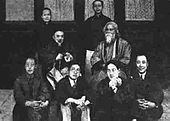
୧୯୦୧ରୁ ସେ ଶିଳାଧା ଛାଡି ଶାନ୍ତିନିକେତନ(ପଶ୍ଚିମବଙ୍ଗ)କୁ ଚାଲିଆସିଥିଲେ, ସେଠାରେ ସେ ଆଶ୍ରମ ,ପ୍ରାର୍ଥନା ଗୃହ,ବିଦ୍ୟାଳୟ, ପାଠାଗାର ନିର୍ମାଣ କରିଥିଲେ । [୪୨] ସେଠାରେ ସେ ବହୁତ ପ୍ରକାର ଗଛ ଲଗାଇ ସୁନ୍ଦର ବଗିଚା ତିଆରି କରିଥିଲେ । ସେଠାରେ ତାଙ୍କ ପତ୍ନୀଙ୍କ ,୨ପିଲାଙ୍କ ମୃତ୍ୟୁ ହୋଇଥିଲା, ସେଠାରେ ମଧ୍ୟ ତାଙ୍କ ବାପାଙ୍କର ମୃତ୍ୟୁ ୧୯୦୫ ଜାନୁୟାରୀ ୧୯ରେ ହୋଇଥିଲା । ସେ ମାସିକିୟା ପାଉଣା ନିଜ ସମ୍ପତ୍ତିରୁ ପାଉଥିଲେ ଓ ତ୍ରିପୁରା ରାଜା ମାସକୁ ମାସ ସାହାଯ୍ୟ କରୁଥିଲେ, ସେ ନିଜ ସ୍ତ୍ରୀଙ୍କ ଅଳଙ୍କାର, ପୁରୀ ସମୁଦ୍ର କୂଳରେ ଅବସ୍ଥିତ ବଙ୍ଗଳା ଓ ବ୍ୟାକରଣାତ୍ମକ ବହିକୁ ୨,୦୦୦ ଟଙ୍କାରେ ବିକ୍ରି କରି ଦେଇଥିଲେ । [୪୩] ବଙ୍ଗଳା ଓ ଇଂରାଜୀ ପଢ଼ିବା ପାଇଁ ଏକ ପଦ୍ଧତି ବାହାର କରିଥିଲେ, ସେ ସମୟରେ ଟାଗୋର ନୈବେଦ୍ୟ (୧୯୦୧)ଓ କ୍ଷେୟ (୧୯୦୬)ରେ ନିଜ ଭାଷାରେ କବିତା ରଚନା କରିଥିଲେ ।
୧୯୧୩ରେ ଟାଗୋର ନବୋଲ ପୁରସ୍କାର ପାଇଲେ ସାହିତ୍ୟିକରେ ଯେଉଁଟା କି ସ୍ୱଦେଶୀ ଆକଡମୀ ଆଦର୍ଶବାଦ ହିସାବରେ ମୁଖ୍ୟଥିଲା ଏବଂ ପାଶ୍ଚାତ ମାନବମାନଙ୍କ ପାଇଁ ତାଙ୍କର ରଚିତ ଛୋଟ ଛୋଟ ଅନୁବାଦ କରିଥିଲେ ଗୀତାଞ୍ଜଳି ବହିରେ ୧୯୧୨ରେ ପ୍ରକାଶ ପାଇଥିଲା । [୪୪] ୧୯୧୫ରେ ତାଙ୍କ ଜନ୍ମ ଦିନରେ ରାଜା ଗେଓରେଗ ତାଙ୍କୁ ନାଇଟହୁଡ଼ ସମ୍ମାନୀତ କରିଥିଲେ କିନ୍ତୁ ୧୯୧୯ ଜଲିୱନାବାଗ ହତ୍ୟାକାଣ୍ଡ ପରେ ସେ ସନମ୍ମାନକୁ ଫେରାଇ ଦେଇଥିଲେ । [୪୫]
୧୯୨୧ରେ ଟାଗୋର ଏବଂ କୃଷି ସମ୍ଭଦ୍ଧିୟ ଅର୍ଥବିତ Leonard Elmhirst ତା ନାମ "Institute for Rural Reconstruction", ପରେ ତା ନାମ ଶ୍ରୀନିକେତନ କିମ୍ବା "ସୁଖର ବାସଗୃହ", ସୁରୁଲ,ଆଶ୍ରମ ପାଖରେ ଗୋଟେ ଗାଁ । ଟାଗୋର ଗାନ୍ଧିଜୀଙ୍କ ସହ ସ୍ୱରାଜ ଆନ୍ଦୋଳନରେ ଯୋଗ ଦେଇଥିଲେ, ସେ ବେଳେବେଳେ ବ୍ରିଟିଶମାନଙ୍କୁ ଭାରତୀୟ ଲୋକମାନଙ୍କୁ ମାନସିକ ଅଶାନ୍ତି ପାଇଁ ଦୋଷଦଉଥିଲେ ।[୪୬] ସେ ଗାଁ ମାନଙ୍କପାଇଁ ମାଗଣାରେ ସେବା ଦେବାପାଇଁ ଦାତାମାନଙ୍କଠାରୁ, ବିଦ୍ୱାନମାନଙ୍କଠାରୁ, ଅଧିକାରୀମାନଙ୍କଠାରୁ ସହାୟତା ମାଗୁଥିଲେ, ଗାଁ ଲୋକମାନଙ୍କୁ ଅଜ୍ଞାନ ଓ ଲୋଭୀ ମଣିଷଠାରୁ ଦୂରରେ ରଖିବା ପାଇଁ ପ୍ରୟାସ କରୁଥିଲେ । [୪୭][୪୮] ଭାରତର ସମାଜିକ ବ୍ୟବସ୍ଥାରେ ଦଳିତମାନେ ନିମ୍ମନତ୍ତର/ଅବହେଳିତ,ଭଗବାନଙ୍କ ପୂଜା ସ୍ଥାନରେ, ଓ ବିଭିନ୍ନ କାର୍ଯ୍ୟରେ ଯୋଗ ଦେବାପାଇଁ ଦଳିତମାନଙ୍କୁ ଅନୁମତି ମିଳେନି, ସେ କେରଳର ଗୁରୁବାରୀ ମନ୍ଦିରକୁ ଦଳିତ ଲୋକମାନଙ୍କୁ ଯିବା ଅନୁମତି ପାଇଁ ଅଧିକାରୀଙ୍କ ପାଖରେ ସେ ଅନୁରୋଧ/ଅପିଲ କରିଥିଲେ। [୪୯][୫୦]
ଶେଷସମୟ(୧୯୩୨-୧୯୪୧)
[ସମ୍ପାଦନା]
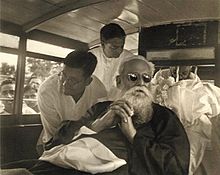
ରବିନସନ ଓ ଦତ୍ତ ଟାଗୋରଙ୍କ ଜୀବନର କାହାଣୀ "peripatetic litterateur"ରେ ଲେଖିଥିଲେ । ୧୯୩୪ ମସିହାରେ ବିହାରରେ ବଡ଼ ଧରଣର ଭୂମିକମ୍ପ ହୋଇଥିଲା, ସେଥିରେ ହଜାର ହଜାର ଲୋକ ମୃତାହତ ହୋଇଥିଲ। [୫୧]ସେ ୫୦ଟି ନୂତନ ଗ୍ରନ୍ଥମାନ ଲେଖିଥିଲେ, ତା ମଧ୍ୟରୁ ଗଳ୍ପ-କବିତା ପୁଷ୍ପଗୁଚ୍ଛ(୧୯୩୨), ଶେଷ ସପ୍ତକ (୧୯୩୫), ଏବଂ ପତ୍ରପୁଟ (୧୯୩୬). ଲେଖିବା ଚାଲୁ ରଖିଥିଲେ ଗଳ୍ପ-ଗୀତ ଏବଂ ନୃତ୍ୟ-ନାଟକ: ଚିତ୍ର (୧୯୧୪), ଶ୍ୟାମା (୧୯୩୯),ଏବଂ ଚଣ୍ଡାଳିକା (୧୯୩୮); ଏବଂ ତାଙ୍କ ପ୍ରବନ୍ଧ: Dui Bon (୧୯୩୩), Malancha (୧୯୩୪), ଏବଂ ଚାରି ଅଧ୍ୟାୟ(୧୯୩୪)। [ଆଧାର ଲୋଡ଼ା]
Clouds come floating into my life, no longer to carry rain or usher storm, but to add color to my sunset sky.
ସେ ବିଜ୍ଞାନର ପକ୍ରିୟା, ବୈଜ୍ଞାନିକମାନଙ୍କର ବିବରଣୀ, ସେ ଗଳ୍ପ ମଧ୍ୟରେ ପ୍ରକାଶ କରିଥିଲେ, ସେ(୧୯୩୭),ତିନ ସଙ୍ଗୀ(୧୯୪୦), ଗଳ୍ପସଳ୍ପ (୧୯୪୧) । ତାଙ୍କର ଶେଷ ପାଞ୍ଚବର୍ଷ ପୁରୁଣା କଷ୍ଟ ଓ ରୋଗଦ୍ୱାରା ଆକ୍ରାନ୍ତ ହୋଇଥିଲେ । ଏସବୁ ୧୯୩୭ରେ ଆରମ୍ଭ ହୋଇଥିଲା ଯେତେବେଳେ ସେ ଚେତା ଶୂନ୍ୟ ହୋଇଯାଇଥିଲା, ସେ ବହୁସମୟ ଧରି କୋମା ଅବସ୍ଥାରେ ଥିଲେ ,ଯାହା ପାଇଁ ସେ ମୃତ୍ୟୁର ନିକଟତର ହୋଇଥିଲେ । ସେ ସମୟରେ ଦୀର୍ଘସମୟଧରି ଅତ୍ୟଧିକ ଯନ୍ତ୍ରଣା ଭୋଗ କରୁଥିଲେ, ୭ ଅଗଷ୍ଟ ୧୯୪୧ରେ ମୃତ୍ୟୁବରଣ କରିଥିଲେ ୮୦ବର୍ଷ ବୟସରେ; ସେ ଜୋରାସଙ୍କ ଭବନର ଉପର ମହଲାରେ ପ୍ରାଣତ୍ୟାଗ କରିଥିଲେ । ସେ ତାରିଖରେ ଆଜି ପର୍ଯ୍ୟନ୍ତ ଶୋକ ବ୍ୟକ୍ତ କରାଯାଉଛି । ଏ. କେ. ସେନ, ପ୍ରଥମ ମୁଖ୍ୟ ନିର୍ବାଚନ କମିଶନଙ୍କ ଭାଇ, ୩୦ ଜୁଲାଇ ୧୯୪୧ ସେ ଟାଗୋରଙ୍କଠୁ ଆଗୁଆ ହୁକୁମ ପାଇଥିଲେ କି ନିର୍ଦ୍ଧାରିତ କାର୍ଯ୍ୟ ସମାପ୍ତ ପାଇଁ-ତାଙ୍କର ଶେଷ କବିତା । [୫୨]
ସେ ତାଙ୍କ ସାଙ୍ଗ, ତାଙ୍କ ସ୍ପର୍ଶ, ଏବଂ ପୃଥିବୀ ପୃଷ୍ଟ/ଧରିତ୍ରୀ ମାର ଶେଷ ଭଲ ପାଇବା ଚାହୁଁଥିଲେ।ମୁଁ ମୋ ଜନ୍ମଦିନ ମଝିରେ ହଜିଯାଇଛି । ମୁଁ ମୋ ଜୀବନର ଶେଷ ଉପହାର/ଭେଟି ଚାହୁଁଚି, ମୁଁ ଦେଶବାସୀଙ୍କ ଭଲପାଇବା ଓ ଆଶ୍ରୀବାଦ। ବର୍ତ୍ତମାନ ମୋ ମୁଣି ଖାଲି ମୁଁ ସବୁ କିଛି ଦେଇ ସାରିଛି ଯାହା ଦରକାର ଥିଲା । ତା ବଦଳରେ ମୁଁ କିଛି ପାଇବାକୁ /ଗ୍ରହଣ ବାକୁ ଚାହୁଁଚି ଯେମିତି କି-ଭଲ ପାଇବା ,କ୍ଷମା ଏହା ମୋ ସହ ମୋ ଶେଷ ସମୟ ପର୍ଯ୍ୟନ୍ତ ମୋ ସହ ରହିବ, ଯେତେବେଳେ କି ମୁଁ ମୋ ଜୀବନ ଡଙ୍ଗାରେ ଧରା ପୃଷ୍ଟରୁ ବିଦାୟ ନଉଥିବୀ ।
I'm lost in the middle of my birthday. I want my friends, their touch, with the earth's last love. I will take life's final offering, I will take the human's last blessing. Today my sack is empty. I have given completely whatever I had to give. In return if I receive anything—some love, some forgiveness—then I will take it with me when I step on the boat that crosses to the festival of the wordless end.
ଯାତ୍ରା
[ସମ୍ପାଦନା]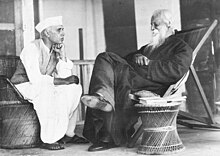
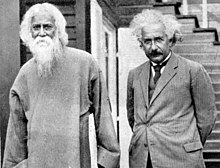

Our passions and desires are unruly, but our character subdues these elements into a harmonious whole. Does something similar to this happen in the physical world? Are the elements rebellious, dynamic with individual impulse? And is there a principle in the physical world which dominates them and puts them into an orderly organization?
କାମ
[ସମ୍ପାଦନା]
ଗୀତ
[ସମ୍ପାଦନା]the pathos of the purabi raga reminded Tagore of the evening tears of a lonely widow, while kanara was the confused realization of a nocturnal wanderer who had lost his way. In bhupali he seemed to hear a voice in the wind saying 'stop and come hither'.Paraj conveyed to him the deep slumber that overtook one at night's end.[୨୩]
ଚିତ୍ରକଳା
[ସମ୍ପାଦନା]Surrounded by several painters Rabindranath had always wanted to paint. Writing and music, playwriting and acting came to him naturally and almost without training, as it did to several others in his family, and in even greater measure. But painting eluded him. Yet he tried repeatedly to master the art and there are several references to this in his early letters and reminiscence. In 1900 for instance, when he was nearing forty and already a celebrated writer, he wrote to Jagadishchandra Bose, "You will be surprised to hear that I am sitting with a sketchbook drawing. Needless to say, the pictures are not intended for any salon in Paris, they cause me not the least suspicion that the national gallery of any country will suddenly decide to raise taxes to acquire them. But, just as a mother lavishes most affection on her ugliest son, so I feel secretly drawn to the very skill that comes to me least easily." He also realized that he was using the eraser more than the pencil, and dissatisfied with the results he finally withdrew, deciding it was not for him to become a painter.[୫୮]
ନାଟ୍ୟଶାଳ
[ସମ୍ପାଦନା]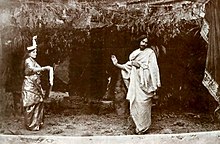
[I]n days long gone by [...] I can see [...] the King's postman coming down the hillside alone, a lantern in his left hand and on his back a bag of letters climbing down for ever so long, for days and nights, and where at the foot of the mountain the waterfall becomes a stream he takes to the footpath on the bank and walks on through the rye; then comes the sugarcane field and he disappears into the narrow lane cutting through the tall stems of sugarcanes; then he reaches the open meadow where the cricket chirps and where there is not a single man to be seen, only the snipe wagging their tails and poking at the mud with their bills. I can feel him coming nearer and nearer and my heart becomes glad.
but the meaning is less intellectual, more emotional and simple. The deliverance sought and won by the dying child is the same deliverance which rose before his imagination, [...] when once in the early dawn he heard, amid the noise of a crowd returning from some festival, this line out of an old village song, "Ferryman, take me to the other shore of the river." It may come at any moment of life, though the child discovers it in death, for it always comes at the moment when the "I", seeking no longer for gains that cannot be "assimilated with its spirit", is able to say, "All my work is thine".[୬୦]
— W. B. Yeats, Preface, The Post Office, 1914.
ଉପନ୍ୟାସ
[ସମ୍ପାଦନା]ଗଳ୍ପ
[ସମ୍ପାଦନା]କବିତା
[ସମ୍ପାଦନା]The time that my journey takes is long and the way of it long.
I came out on the chariot of the first gleam of light, and pursued my voyage through the wildernesses of worlds leaving my track on many a star and planet.
It is the most distant course that comes nearest to thyself, and that training is the most intricate which leads to the utter simplicity of a tune.
The traveller has to knock at every alien door to come to his own, and one has to wander through all the outer worlds to reach the innermost shrine at the end.
My eyes strayed far and wide before I shut them and said 'Here art thou!'
The question and the cry 'Oh, where?' melt into tears of a thousand streams and deluge the world with the flood of the assurance 'I am!'
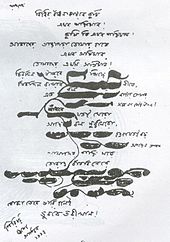 |
 |
Song VII of Gitanjali:
|
|
Amar e gan chheŗechhe tar shôkol ôlongkar |
Tagore's free-verse translation:
My song has put off her adornments.
She has no pride of dress and decoration.
Ornaments would mar our union; they would come
between thee and me; their jingling would drown thy whispers.
My poet's vanity dies in shame before thy sight.
O master poet, I have sat down at thy feet.
Only let me make my life simple and straight,
like a flute of reed for thee to fill with music.[୬୨]
"Klanti" (ক্লান্তি; "Weariness"):
|
ক্লান্তি আমার ক্ষমা করো প্রভু, |
Klanti amar khôma kôro probhu, |
Gloss by Tagore scholar Reba Som:
Forgive me my weariness O Lord
Should I ever lag behind
For this heart that this day trembles so
And for this pain, forgive me, forgive me, O Lord
For this weakness, forgive me O Lord,
If perchance I cast a look behind
And in the day's heat and under the burning sun
The garland on the platter of offering wilts,
For its dull pallor, forgive me, forgive me O Lord.
[୬୩]
ରାଜନୀତି
[ସମ୍ପାଦନା]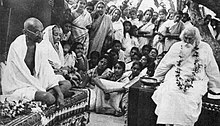
ଟାଗୋର ସାମ୍ରାଜ୍ୟବାଦକୁ ବିରୋଧ କରୁଥିଲେଓ ରାଷ୍ଟ୍ରୀୟବାଦକୁ ସମର୍ଥନ କରୁଥିଲେ,ଏ ସବୁ ମତପ୍ରକଟ କରିବା ପାଇଁ ସେ ମନସ୍ଥ କରିଥିଲେ,ତାହା ସେ twentiesରେ ରଚିତ କରିଥିଲେ।ପ୍ରମାଣ ଅବଗତ କରାଇଥିଲେ ଯେତେବେଳେ ହିନ୍ଦୁ-ଜର୍ମାନୀ ଷଡଯନ୍ତ୍ରର ଅବଗତ କରିବା ପାଇଁ ବିଚାର କରିବ ପାଇଁ ସେ ଚିଠି ଲେଖିଥିଲେ,ସେ ଜାପାନର ପ୍ରଧାନମନ୍ତ୍ରୀTerauchi Masatake ଓ ପୂର୍ବ ପ୍ରଧାନମନ୍ତ୍ରୀŌkuma Shigenobuଙ୍କ ଠୁ ସାହାଯ୍ୟ ମାଗିଥିଲେ।
So I repeat we never can have a true view of man unless we have a love for him. Civilisation must be judged and prized, not by the amount of power it has developed, but by how much it has evolved and given expression to, by its laws and institutions, the love of humanity.
ପଦମଯ୍ୟଦାର ପ୍ରତ୍ୟାଖ୍ୟାନ
[ସମ୍ପାଦନା]ଶାନ୍ତିନିକେତନ ଏବଂ ବିଶ୍ୱ ଭାରତୀ
[ସମ୍ପାଦନା]ନୋବଲପୁରସ୍କାରର ଚୋର
[ସମ୍ପାଦନା]ଧକ୍କା ଓ ଇଚ୍ଛାପତ୍ର
[ସମ୍ପାଦନା]
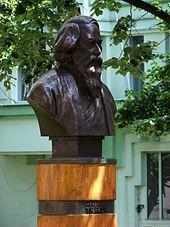 |
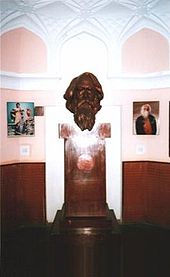 |
Who are you, reader, reading my poems a hundred years hence?
I cannot send you one single flower from this wealth of the spring, one single streak of gold from yonder clouds.
Open your doors and look abroad.
From your blossoming garden gather fragrant memories of the vanished flowers of an hundred years before.
In the joy of your heart may you feel the living joy that sang one spring morning, sending its glad voice across an hundred years.

Anyone who knows Tagore's poems in their original Bengali cannot feel satisfied with any of the translations (made with or without Yeats's help). Even the translations of his prose works suffer, to some extent, from distortion. E.M. Forster noted [of] The Home and the World [that] '[t]he theme is so beautiful,' but the charms have 'vanished in translation,' or perhaps 'in an experiment that has not quite come off.'
— Amartya Sen, "Tagore and His India".[୬୬]
ଆଧାର
[ସମ୍ପାଦନା]- ↑ "Tagore, Sir Rabindranath", in Webster's Biographical Dictionary (1943), Springfield, MA: G. & C. Merriam.
- ↑ "Work of Rabindranath Tagore celebrated in London - BBC News". BBC News (in ବ୍ରିଟିଶ୍ ଇଂରାଜୀ). Retrieved 15 July 2015.
- ↑ O'Connell 2008.
- ↑ Habib, Haroon (17 May 2011). "Celebrating Rabindranath Tagore's legacy". The Hindu.
- ↑ Haque, Junaidul (7 May 2011). "Rabindranath: He belonged to the world". The Daily Star (Bangladesh). Archived from the original on 4 March 2016. Retrieved 1 February 2016.
- ↑ de Silva, K. M.; Wriggins, Howard (1988). J. R. Jayewardene of Sri Lanka: a Political Biography - Volume One: The First Fifty Years. University of Hawaii Press. p. 368. ISBN 0-8248-1183-6.
- ↑ "Man of the series: Nobel laureate Tagore". The Times of India. Times News Network. 3 April 2011.
- ↑ "How Tagore inspired Sri Lanka's national anthem". IBN Live. 8 May 2012. Archived from the original on 10 May 2012. Retrieved 1 February 2016.
- ↑ Tagore 1984, p. xii.
- ↑ Thompson 1926, pp. 27–28.
- ↑ Dasgupta 1993, p. 20.
- ↑ "Nationalism is a Great Menace" Tagore and Nationalism, by Radhakrishnan M. and Roychowdhury D. from Hogan, P. C.; Pandit, L. (2003), Rabindranath Tagore: Universality and Tradition, pp 29-40
- ↑ "Visva-Bharti-Facts and Figures at a Glance". Archived from the original on 2007-05-23. Retrieved 2016-02-01.
- ↑ Datta 2002, p. 2.
- ↑ Kripalani 2005a, pp. 6–8.
- ↑ Kripalani 2005b, pp. 2–3.
- ↑ Thompson 1926, p. 12.
- ↑ Dutta & Robinson 1995, p. 34.
- ↑ Dutta & Robinson 1995, p. 37.
- ↑ The News Today 2011.
- ↑ Roy 1977, pp. 28–30.
- ↑ Tagore, Dutta & Robinson 1997, pp. 8–9.
- ↑ ୨୩.୦ ୨୩.୧ ୨୩.୨ Ghosh 2011.
- ↑ ୨୪.୦ ୨୪.୧ Thompson 1926, p. 20.
- ↑ Tagore, Dutta & Robinson 1997, p. 10.
- ↑ Thompson 1926, pp. 21–24.
- ↑ Das 2009.
- ↑ Dutta & Robinson 1995, pp. 48–49.
- ↑ Dutta & Robinson 1995, pp. 50.
- ↑ (Dutta & Robinson 1995, pp. 55–56).
- ↑ (Stewart & Twichell 2003, p. 91).
- ↑ (Stewart & Twichell 2003, p. 3).
- ↑ Tagore, Stewart & Twichell 2003, p. 3.
- ↑ ୩୪.୦ ୩୪.୧ Tagore & Chakravarty 1961, p. 45.
- ↑ Tagore, Dutta & Robinson 1997, p. 265.
- ↑ Dutta & Robinson 1995, p. 68.
- ↑ Dutta & Robinson 1995, p. 373.
- ↑ Scott 2009, p. 10.
- ↑ Dutta & Robinson 1995, pp. 109–111.
- ↑ Chowdury, A. A. (1992), Lalon Shah, Dhaka, Bangladesh: Bangla Academy, ISBN 984-07-2597-1
- ↑ Dutta & Robinson 1995, p. 109.
- ↑ Dutta & Robinson 1995, p. 133.
- ↑ Dutta & Robinson 1995, pp. 139–140.
- ↑ Hjärne 1913.
- ↑ Anil Sethi; Guha; Khullar; Nair; Prasad; Anwar; Singh; Mohapatra, eds. (2014). "The Rowlatt Satyagraha". Our Pasts: Volume 3, Part 2 (History text book) (Revised 2014 ed.). India: NCERT. p. 148. ISBN 9788174508386.
- ↑ Dutta & Robinson 1995, pp. 239–240.
- ↑ Dutta & Robinson 1995, p. 242.
- ↑ Dutta & Robinson 1995, pp. 308–309.
- ↑ Dutta & Robinson 1995, p. 303.
- ↑ Dutta & Robinson 1995, p. 309.
- ↑ Dutta & Robinson 1995, p. 342.
- ↑ Sigi 2006, p. 89.
- ↑ Flickr 2006.
- ↑ Tagore 1930, pp. 222–225.
- ↑ Dyson 2001.
- ↑ Som 2010, p. 38.
- ↑ "Tabu mone rekho" (in Bengali). tagoreweb.in. Archived from the original on 20 February 2019. Retrieved 11 May 2012.
- ↑ R. Siva Kumar (2011) The Last Harvest: Paintings of Rabindranath Tagore.
- ↑ Tagore & Mukerjea 1914, p. 68.
- ↑ Tagore & Mukerjea 1914, pp. v–vi.
- ↑ Prasad & Sarkar 2008, p. 125.
- ↑ Tagore 1952, p. 5.
- ↑ Tagore, Alam & Chakravarty 2011, p. 323.
- ↑ Tagore 1916, p. 111.
- ↑ Tagore & Ray 2007, p. 104.
- ↑ Sen 1997.
ଅଧିକ ତଥ୍ୟ
[ସମ୍ପାଦନା]- ↑ Romanised from Bengali script: Robindronath Ţhakur.
- ↑ Bengali calendar: 25 Baishakh, 1268 – 22 Srabon, 1348 (২৫শে বৈশাখ, ১২৬৮ – ২২শে শ্রাবণ, ১৩৪৮ বঙ্গাব্দ).
- ↑ Tagore was born at No. 6 Dwarkanath Tagore Lane, Jorasanko — the address of the main mansion (the Jorasanko Thakurbari) inhabited by the Jorasanko branch of the Tagore clan, which had earlier suffered an acrimonious split. Jorasanko was located in the Bengali section of Calcutta, near Chitpur Road.[୧୮][୧୯] Dwarkanath Tagore was his paternal grandfather.[୨୦] Debendranath had formulated the Brahmoist philosophies espoused by his friend Ram Mohan Roy, and became focal in Brahmo society after Roy's death.[୨୧][୨୨]
- ↑ ... and wholly fictitious ...
Analyses
- Tagore, ..., Banglapedia
- ... and His India Archived 2011-10-09 at the Wayback Machine., The New York Review of Books
- ... Current Articles, Parabaas
- ... The Founder Archived 2005-12-15 at the Wayback Machine., Visva-Bharati University
- Mary Lago Collection Archived 2013-07-19 at the Wayback Machine., University of Missouri
Audiobooks
- Sadhana: ..., LibriVox
Talks
- ... with Albert Einstein and H. G. Wells Archived 2000-03-09 at the Wayback Machine., School of Wisdom
Texts


